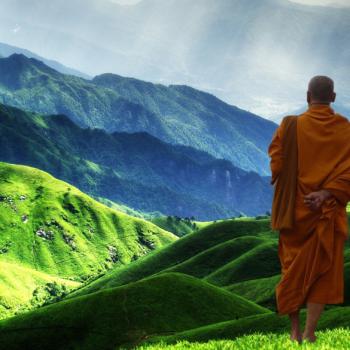
Religious tourism inspires adventurers for a multitude of reasons. Perhaps you wish to fulfil a pilgrimage meaningful to your faith. You may be a fan of sightseeing and desire selfies with recognisable landmarks. Or you’re like me and travel to amplify your spirituality until your soul explodes and you merge with the metaphysical Universe.
Whatever your motivation, the list of historical stops would take books to complete, but here are ten ideas to get your feet moving.
1. St. Peter’s Basilica (Christian)

Vatican City, Italy
The independent Vatican City is ruled by the Pope, already making for a noteworthy Catholic holy ground. However, St. Peter’s Basilica steals the show as the largest church in the world. It is famous for its breathtaking architecture and masterpiece artworks, which include Michelangelo’s Pietà sculpture.
Why is it Sacred?
They named the Basilica after St. Peter the Apostle, arguably the first leader of the Christian Church. Catholics are adamant he is buried beneath the altar. Although, it’s fair to mention that no one can verify this assumption.
Know Before You Go
- Respectful attire (no hats, flip-flops, shorts, or short skirts) is necessary.
- Be prepared for long queues.
- The Basilica is free to enter, but the surrounding museums (including the Sistine Chapel) charge admission. They are worth the price!
2. Uluru (Indigenous Culture)

Northern Territory, Australia
Uluru (also known as Ayers Rock) is a 550 million-year-old sandstone. It is a monumental geographical spectacle, sitting 348 meters tall with a circumference of nearly 10 kilometres. And due to its blood-red surface that glows at sunset, it’s no wonder that tourists and indigenous people alike flock to its presence daily.
Why is it Sacred?
According to the local Anangu legend, Uluru is a physical manifestation of their ancestors. Even its crevices reveal ancient stories that cross into spiritual realms.
Know Before You Go
- Most visitors take the 5.5-hour drive from the nearby town of Alice Springs.
- Be warned: sunstroke and dehydration are common!
- Prepare yourself for a swarm of flies.
- Please respect the culture by not climbing the rock (now illegal) or taking photos of holy regions (signs inform where).
3. Masjid al-Haram (Islam)
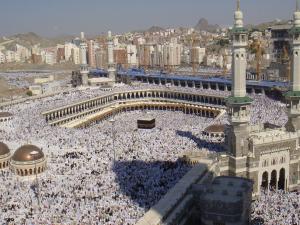
Mecca, Saudi Arabia
Mecca is the holiest city in Islam. Here you’ll find the Masjid al-Haram, the largest mosque in existence. The iconic Kaaba is a cube-shaped temple situated directly in the centre of this site. Muslims around the globe face the direction of the Kaaba during prayer.
Why is it Sacred?
Mecca is the birthplace of the Prophet Muhammad. It is so sacred that the pilgrimage to Mecca is obligatory for all Muslims. The journey is one of the Five Pillars of Islam (known as Hajj).
Know Before You Go
- Wear easily removable footwear.
- Do not carry non-Islamic materials, including pork.
- Only Muslims are permitted into Mecca.
- Non-Muslims attempting to enter Mecca may be fined and deported from Saudi.
4. Mahabodhi Temple (Buddhism)
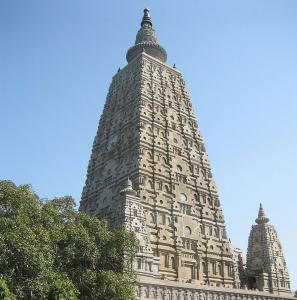
Bodh Gaya, Bihar, India
The Mahabodhi Temple translates to the “Great Awakening Temple”. Elements of its construction date back to 232 BCE, and it has stood as a Buddhist pilgrimage destination for over two thousand years.
Why is it Sacred?
Within the Mahabodhi Temple Complex, everyone gathers around the Bodhi Tree. They say that Siddhartha Gautama (The Buddha) attained enlightenment by sitting under this tree for 49 days. Hence, the religion regards it as their holiest of spots.
Know before you go
- Dress modestly.
- Removable footwear is a must.
- Electrical supply is known to be sporadic. Bring a torch.
- Always check the weather first.
5. Temple Mount (Judaism)
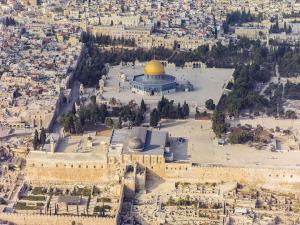
Old City of Jerusalem
Temple Mount may stand as the holiest site in Judaism, but Christianity and Islam are also extremely fond of the location. The place is so religiously significant on the Abrahamic timeline that it remains a painful topic of the Israeli–Palestinian conflict. So much so that both Israel and Palestine claim Jerusalem as their capital city.
Why is it Sacred?
It depends on who you ask. Some say the central Jewish text, the Talmud, claims the Foundation Stone in the temple is from where God created the world. They further map out various Biblical stories to the grounds.
For Muslims, Temple Mount (or Al-Aqsa Mosque) is their third holiest landmark. It falls behind only the Kaaba (Mecca) and Al-Masjid an-Nabawi (Medina Province), both in Saudi Arabia. They believe that Muhammad ascended to heaven from this area.
Christians claim it as a temple where Jesus once taught. However, they are less precious about the region than the previous two.
Know Before You Go
- Check opening times, as they are very specific.
- Authorities may ask to see your passport.
- Non-Muslims are forbidden to pray or to carry religious materials.
- Non-Muslims cannot enter the Dome of the Rock or Al-Aqsa Mosque.
- Dress modestly to cover your legs and shoulders.
- If you are Jewish, evaluate how close you are willing to stand to the Holy of Holies Tabernacle, as it is a controversial action.
6. Varanasi (Hindu)
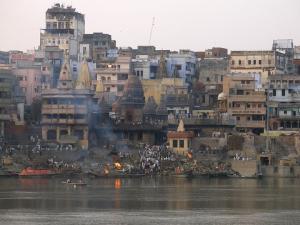
Varanasi, India
Along the river Ganges, you’ll find Varanasi. It’s one of the oldest inhabited cities in the world, called home to Indian communities since 1200 BC. It has been recognised as an essential Hindu pilgrimage stop from ancient times until today.
Why is it Sacred?
Established to worship the God of Destruction, Shiva, a large part of Varanasi’s reputation is its dealings with life and death. Most notable is the cremation site, Manikarnika Ghat. The religion tells us that if you die and are cremated along the Ganges, you can attain moksha, breaking the karmic rebirth cycle.
Know Before You Go
- View the cremations respectfully with an open mind.
- Be wary of scams and naughty monkeys.
- Note that the heat is unbearable during the summer.
- Do not bathe in the river Ganges.
- It is easy to get lost in the alleyways, especially at night.
- Reports of female harassment are common.
7. Stonehenge (Neopagan)
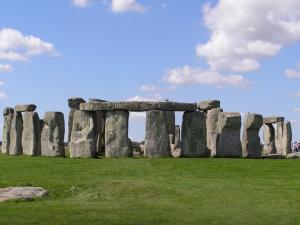
Wiltshire, England, United Kingdom
Stonehenge is one of the most famous landmarks in the world. Constructed between 3,000 BC to 2,000 BC, it is estimated to have taken 1500 years to build. Even more impressive, each stone weighs up to 25 tons and was transported here from roughly 240 km away!
Why is it Sacred?
Part of Stonehenge’s allure is its mystery. There has yet to be an official consensus as to its purpose. However, theories are plentiful and include a burial site, a religious ceremonial zone, or a magical healing location.
Stonehenge is now officially recognised as a holy spot for Neo-Druids and Pagans. The stones are closed off from visitors, except on special holidays for those believers. These dates include the winter and summer solstices.
Know Before You Go
- Stonehenge is always busy, and spaces are limited, so book your tickets in advance.
- There are no shops. Bring food and water.
- As noted above, you can only walk between the stones on select occasions. Otherwise, you are limited to standing 45 feet away.
8. Golden Temple (Sikhism)
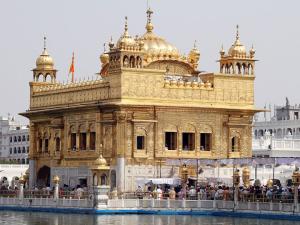
Amritsar, Punjab, India
As far as Sikhism goes, there is no spiritual equivalent to the Golden Temple. Completed in 1589, it was initially known as the Harmandir Sahib. But when the first ruler of the Sikh Empire, Ranjit Singh, overlaid it with gold leaf in 1830, the name Golden Temple stuck. This establishment welcomes faces from every religious denomination and provides free meals to all.
Why is it Sacred?
Unlike most religions, the Sikh’s leading guru is not human. Instead, it is their holy scripture, the Guru Granth Sahib or Adi Granth. These texts were completed and installed in the Golden Tempe in 1604. This divine book is revealed at dawn and is put to bed on an embroidered pillow at night.
Know Before You Go
- It can take hours to get in.
- Both men and women must cover their heads with a scarf. You can buy these outside at a reasonable price.
- Remove your shoes and sunglasses.
- Photography is not allowed.
- Please consider donating to their kitchen, or if you are inspired, why not volunteer?
9. Four Sacred Mountains of Taoism (Taoism)

China
Several spiritual beliefs cherish China’s countless mountain ranges. One set is the Five Great Mountains, associated with cosmic deities from the country’s traditional religion. Another is the Four Sacred Mountains of Buddhism. But we will focus on the Four Sacred Mountains of Taoism: Wǔdāng Shān, Qíyún Shān, Lónghŭ Shān, and Qīngchéng Shān.
Why Are They Sacred?
Taoists revere each mountain for distinct reasons.
Wǔdāng Shān is where they invented Tai chi. A complex of Taoist temples dedicated to the high deity Xuanwu is situated there too.
Qíyún Shān holds many Taoist temples and shrines.
Lónghŭ Shān is renowned as one of the birthplaces of Taoism. This origin mainly concerns the Zhengyi Dao branch.
And Qīngchéng Shān is another Taoist motherland, famed as “the most secluded area in China”.
Know Before You Go
- These mountains are thousands of km apart.
- Some climbs may be challenging depending on the weather and your experience. Do your research carefully!
10. Fire Temple of Yazd (Zoroastrianism)

Yazd, Yazd Province, Iran
Unlike the other entries on this list, the Fire Temple of Yazd was built as recently as 1934. And yet it is often considered the most important location for Zoroastrianism, which itself one of the world’s oldest faiths. How come?
Why is it Sacred?
The temple enshrines the Atash Behram, a fire burning since 470 AD. There are only nine such Zoroaster locations worldwide, but the others are in India. Zoroastrianism originated in Iran (then known as Persia); hence the Fire Temple of Yazd is their most favoured pilgrimage establishment.
Know before you go
- The temple has permitted non-Zoroastrians since the 1960s. However, they are not allowed into the sanctum area of the fire.
- That said, you can view the fire from behind glass.
- Zoroastrians must wear something light in colour and cover their heads (skull cap for men, head scarf for women).





